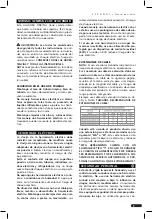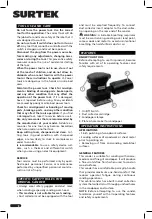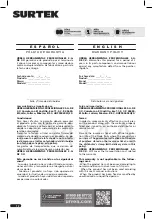
9
E N G L I S H •
User's Manual
SWITCH
This tool is equipped with a simple switch con-
trol. To turn the sander ON slide the switch to
the “ | “ position. To turn it OFF press switch to
the “ O “ position.
WARNING: Do not allow familiarity with the
sander to make you careless, always remember
that a careless fraction of a second suffice to in-
flict serious injury.
BEFORE OPERATION
WARNING: This sander should never be con-
nected to power supply when assembling parts,
making adjustments, assembling or replacing
sandpaper, cleaning or when not in use. Discon-
necting the sander will prevent accidental start-
ing that could cause serious personal injury.
INSTALLING THE SANDPAPER
· Position the sander with its pad side facing up-
ward.
· Place the sandpaper on the pad so that the cen-
ter of the sandpaper is aligned with the center
of the pad and bend both ends of the sanding
paper at 90˚ angle. Then bend both ends again
as to cover the sander base.
· Insert one of the sandpaper ends and secure it
with the clamp, next insert the remaining bent
section in the same way.
CAUTION: The sandpaper must be precisely
installed on the pad, ensuring that there is am-
ple tension. Loosely installed sandpaper could
result in unevenly sanded surfaces and/or dam-
age to the sandpaper itself.
· Use the “plate & hole maker” to make holes in
the sandpaper so the sander can collect the dust
produced during operation.
NOTE: Holes in sandpaper must be lined up with
the holes in the backing pad in order for the
dust collection feature of the sander to function
properly.
DURING OPERATION
WARNINGS
• Be careful not to let your hand completely
cover air vents.
• Secure workpiece. Unsecured workpiece could
be thrown towards operator during sanding
causing injury.
SANDING
Hold the sander in front and away from you,
keeping it clear of the workpiece. Start the
sander and let the motor reach its maximum
speed. Gradually lower the sander on the work-
piece with a slight forward movement. Move it
slowly using forward and backward strokes.
DO NOT FORCE!
The weight of the unit supplies adequate pres-
sure, so let the sandpaper and sander do the
work. Applying additional pressure only slows
the motor, rapidly wears sandpaper and greatly
reduces sander speed.
Excessive pressure will overload the motor caus-
ing possible damage from motor overheating
and can result in inferior work.
NOTE: Any finish or resin on wood may soften
from the frictional heat. Do not allow sanding
on one spot too long as the sander’s rapid ac-
tion may remove too much material, making the
surface uneven.
WARNING: Do not touch workpiece right
after sanding operation it will be hot and may
cause burning.
ORBITAL MOVEMENT
Orbital movement is ideal for fast cutting action
when removing old finishes, smoothing rough
wood, cutting stock down to required dimen-
sions, or for finishing surfaces to be painted.
The sandpaper moves in tiny orbits, allowing
the sandpaper to move easily.
MAINTENANCE
FILTER CARTRIDGE
Empty the collector filter when it gets full, is
recommended the use of an air compressor to
make a greater cleaning. To keep in optimal
function of your sander replace filter regularly.
SANDPAPER
Inspect the sandpaper. The use of worn-out
sandpaper will degrade efficiency and cause
possible damage to the pad, replace the sand-
paper as soon an excessive abrasion is noted.
MOUNTING SCREWS
Regularly inspect all mounting screws and en-
sure that they are properly tightened. Should
any of the screws be loose, retighten them
immediately. Failure to follow this instruction
could result in serious hazard.






























